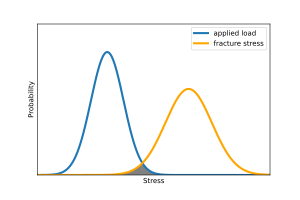
Probabilistic design is a discipline within engineering design. It deals primarily with the consideration and minimization of the effects of random variability upon the performance of an engineering system during the design phase. Typically, these effects studied and optimized are related to quality and reliability. It differs from the classical approach to design by assuming a small probability of failure instead of using the safety factor.[2][3] Probabilistic design is used in a variety of different applications to assess the likelihood of failure. Disciplines which extensively use probabilistic design principles include product design, quality control, systems engineering, machine design, civil engineering (particularly useful in limit state design) and manufacturing.
- ^ Sundarth, S; Woeste, Frank E.; Galligan, William (1978), Differential reliability : probabilistic engineering applied to wood members in bending-tension (PDF), vol. Res. Pap. FPL-RP-302., US Forest Products Laboratory, retrieved 21 January 2015
{{citation}}: CS1 maint: multiple names: authors list (link) - ^ Sundararajan, S (1995). Probabilistic Structural Mechanics Handbook. Springer. ISBN 978-0412054815.
- ^ Long, M W; Narcico, J D (June 1999), Design Methodology for Composite Aircraft Structures, DOT/FAA/AR-99/2, FAA, archived from the original on 3 March 2016, retrieved 24 January 2015
